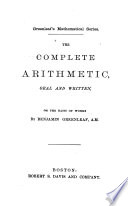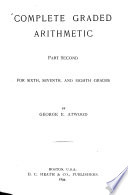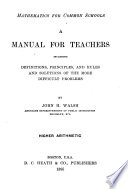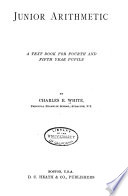 | Joseph Ray - Arithmetic - 1877 - 350 pages
...more numbers may be the common factor. Thus, 6 is a common factor of 6, 12, and 18. 8. Two or more numbers are prime to each other, when they have no common factor. Thus, 9 and 10 are prime to each other. 9. A common divisor (CD) of two or more numbers is any common... | |
 | Henry Bartlett Maglathlin - Arithmetic - 1881 - 418 pages
...the greatest factor found in each of them. Thus, 6 is the greatest common divisor of 18 and 24. 89. Numbers are Prime to each other when they have no common factor or divisor. Thus, 9 and 14 are prime to each other. 90. Principle. The greatest common divisor of two... | |
 | Henry Bartlett Maglathlin - Arithmetic - 1882 - 398 pages
...the greatest factor found in each of them. Thus, 6 is the greatest common divisor of 18 and 24. 89. Numbers are Prime to each other when they have no common factor or divisor. Thus, 9 and 14 are prime to each other. 90. Principle. The greatest common divisor of two... | |
 | George Soulé - Arithmetic - 1888 - 568 pages
...and 1; as 4, 9, 12, 15, 24, eta. All composite numbers are the product of two or more other numbers. Numbers are prime to each other when they have no common factor that will divide each without a remainder ; as G, 13, 20, etc. 153. An Even number is one that can... | |
 | David Martin Sensenig - Algebra - 1890 - 204 pages
...and unity. 891. A Square Number is one that may be resolved into two equal factors. 893. Two or more numbers are prime to each other when they have no common factor, except unity. 2. Primes. 894. Theorem I. — The number of primes is unlimited. For, let n be the number... | |
 | George Edward Atwood - Arithmetic - 1894 - 396 pages
...Divisor of two or more numbers is the greatest number that is an exact divisor of each of them. 62. Numbers are prime to each other when they have no common factor. 63. PRINCIPLES. — 1. Every factor of a number is a divisor of that number. 2. A common factor of... | |
 | John Henry Walsh - 1895 - 296 pages
...Factor (divisor or measure) is the largest number that is a factor of each of two or more numbers. Numbers are prime to each other when they have no common factor. The greatest common divisor of two or more numbers is the product of their common prime factors. PRINCIPLES.... | |
 | Charles Edward White - Arithmetic - 1895 - 248 pages
...prime number used as a factor is a Prime Factor. What are the prime factors of 18? of 20? of 24? of 36? Numbers are Prime to each other when they have no common factor or divisor. 4 and 9 are prime to each other, but are not prime numbers. Name other numbers prime to... | |
 | John Williston Cook, Nebraska Cropsey - Arithmetic - 1896 - 452 pages
...Number is a number that has no factors except itself and 1. 1, 2, 3, 5, etc., are prime numbers. 7. Two numbers are prime to each other when they have no common factor. 8. An Eveu Number is a number that contains 2 as a factor. 4, 6, 8, 10, etc., are even numbers. 9.... | |
 | William Seneca Sutton - 1896 - 342 pages
...factor is 17 ; express the other factor as an improper fraction. 106. Fractions to Lowest Terms. 107. Numbers are prime to each other when they have no common factor. A fraction is in its lowest terms when the numerator and denominator are prime to each other. 29. Eeduce... | |
| |